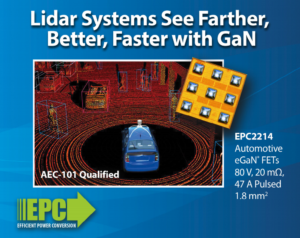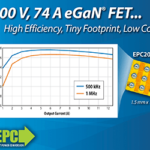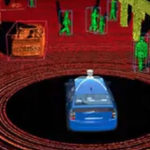 EPC announces successful AEC Q101 qualification of the 80 V EPC2214 designed for lidar systems in the automotive industry and other harsh environments.
EPC announces successful AEC Q101 qualification of the 80 V EPC2214 designed for lidar systems in the automotive industry and other harsh environments.
eGaN technology has been in mass production for over nine years, accumulating billions of hours of successful field experience in automotive applications, such as lidar (Light Detection and Ranging) and radar for autonomous cars, 48 V – 12 V DC-DC converters used in data center computers, ultra-high fidelity infotainment systems, and high-intensity headlamps for trucks. This new device has completed rigorous automotive AEC Q101 qualification testing and will be followed with several more discrete transistors and integrated circuits designed for the harsh automotive environment.
The EPC2214, an 80 V, 20 mΩ, eGaN FET with a 47 A pulsed current rating in a tiny 1.8 mm2 footprint, is perfectly suited to use for firing the lasers in lidar systems because the FET can be triggered to create high-current with extremely short pulse widths. The short pulse width leads to higher resolution, and the higher pulse current allows the lidar system to discern objects at greater distances. These two characteristics, along with their tiny size and low cost, make eGaN FETs ideal for radar and ultrasonic sensors in addition to lidar in demanding automotive applications.
To complete AEC Q101 testing, EPC’s eGaN FETs underwent rigorous environmental and bias-stress testingncluding humidity testing with bias (H3TRB), high temperature reverse bias (HTRB), high temperature gate bias (HTGB), temperature cycling (TC), as well as several other tests. Of note is that EPC’s WLCS packaging passed all the same testing standards created for conventional packaged parts, demonstrating that the superior performance of chip-scale packaging does not compromise ruggedness or reliability. These eGaN devices are produced in facilities certified to the Automotive Quality Management System Standard IATF 16949.
EPC’s CEO and co-founder Alex Lidow notes, “This new automotive product is the most recent in what will be a constant stream of EPC transistors and integrated circuits designed to enable autonomous driving and improve fuel economy and safety. Our eGaN technology is faster, smaller, more efficient, lower cost, and more reliable than the aging silicon power MOSFET used in today’s vehicles.”
The EPC2214 eGaN FET is priced at 2.5Ku/reel at $0.72 each and is available for immediate delivery from Digi-Key at http://www.digikey.com/Suppliers/us/Efficient-Power-Conversion.page?lang=en







Leave a Reply